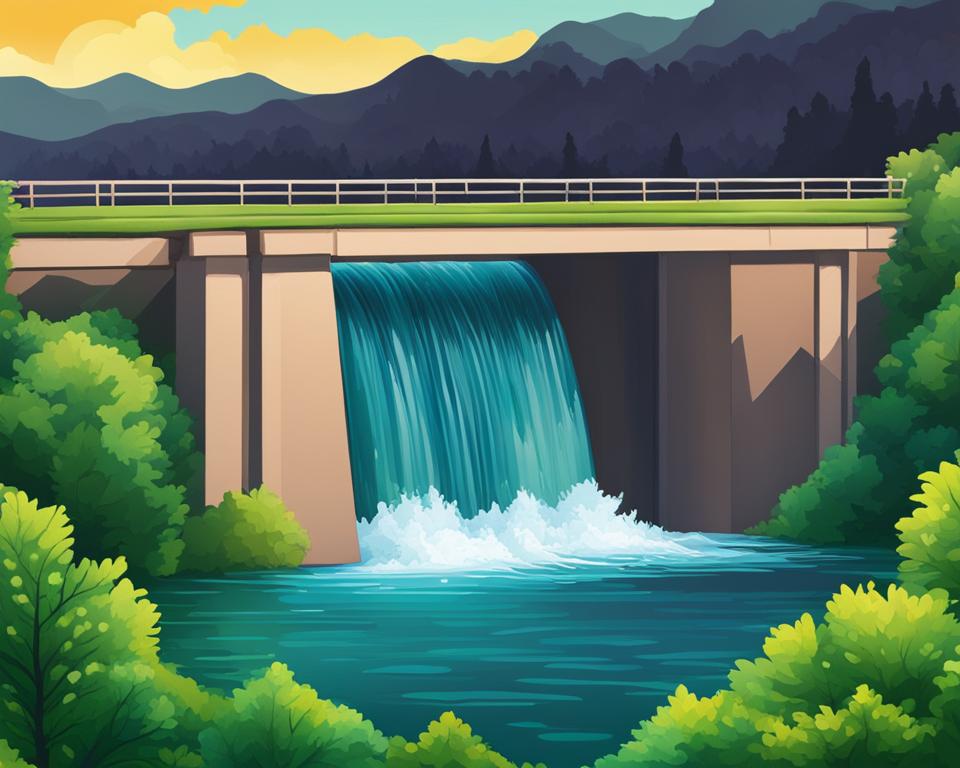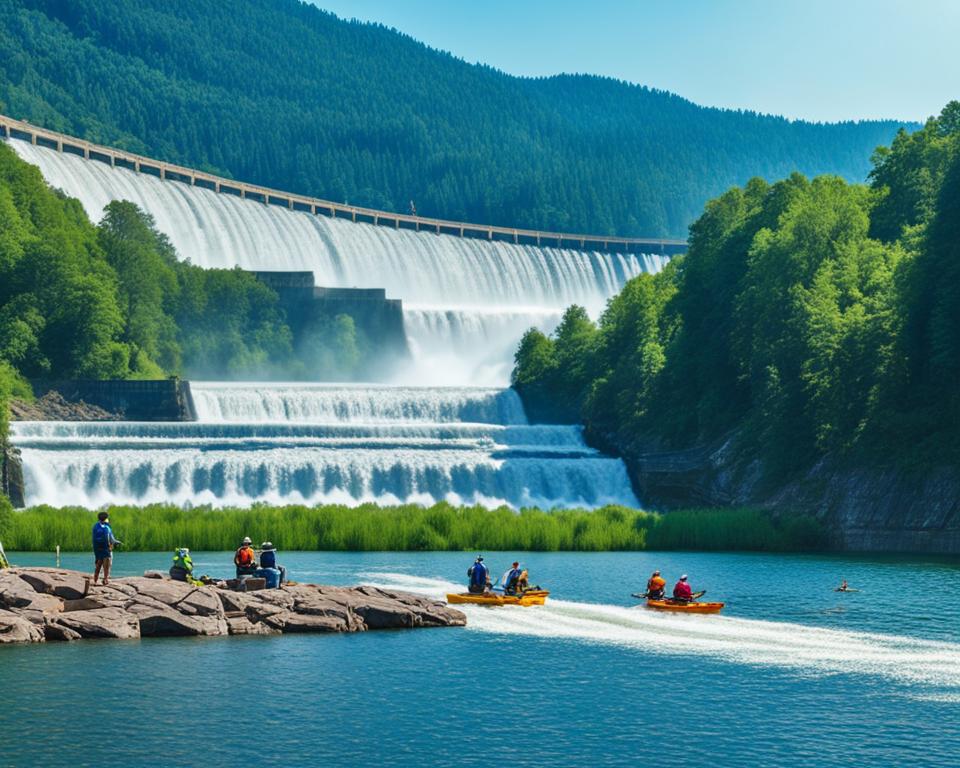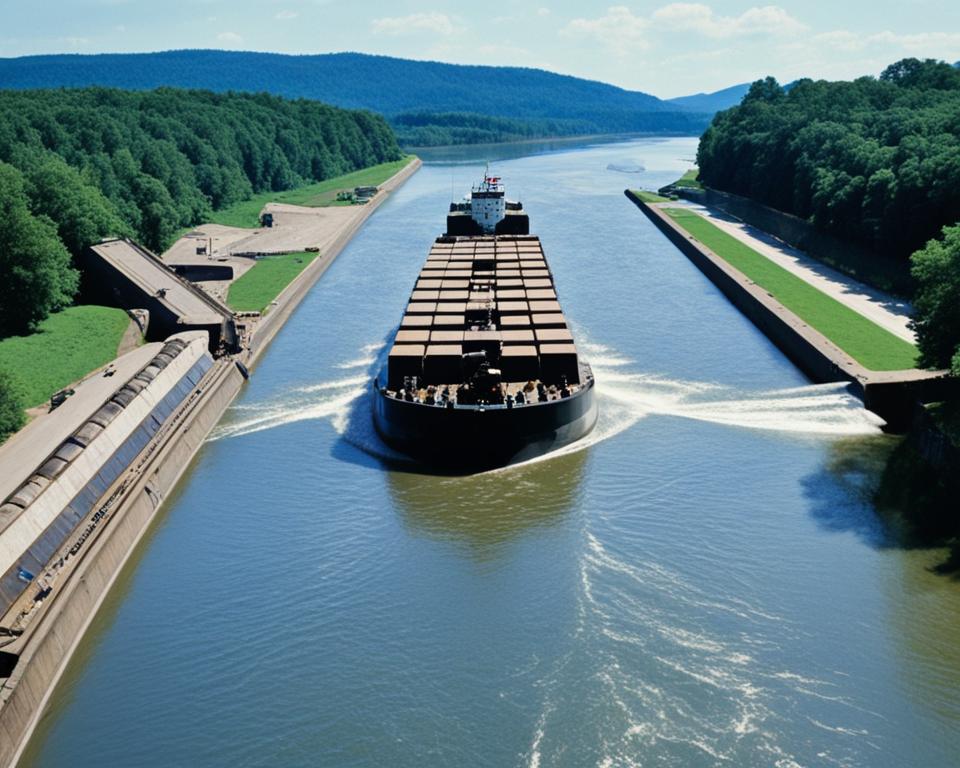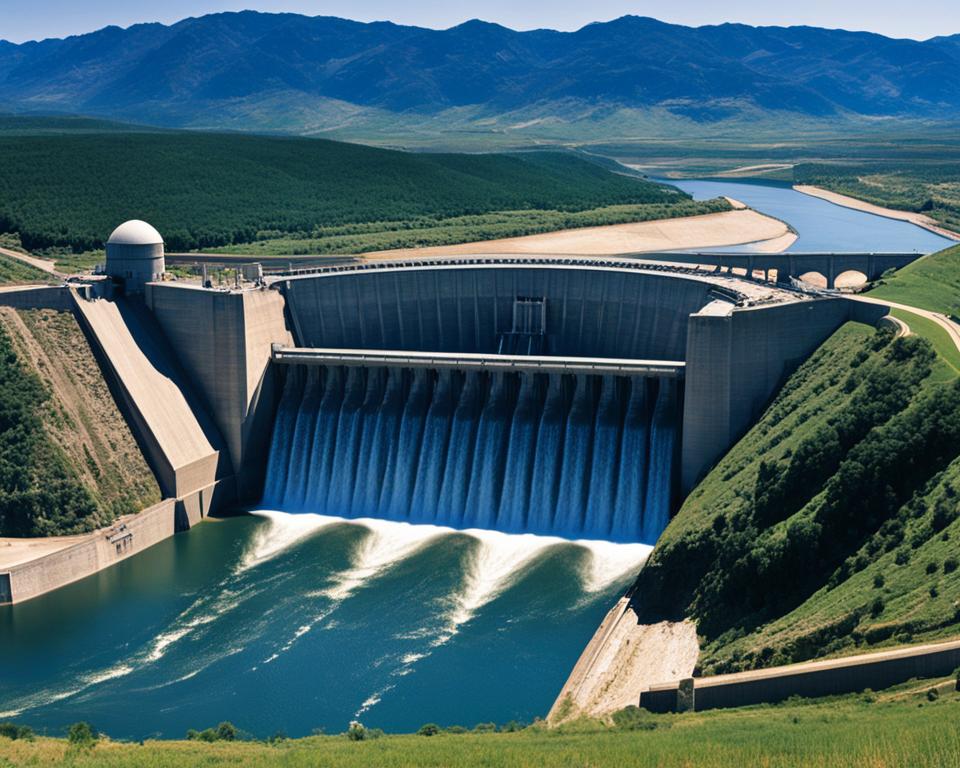Dams are structures built across rivers, streams, and other water bodies to harness their potential for various purposes. These structures have been used throughout history, and their importance in different sectors cannot be overlooked. In this section, we will take a closer look at the different uses of dams.
Key Takeaways
- Dams have multiple uses in different sectors.
- Hydroelectric power generation is one major use of dams.
- Dams are vital for irrigation purposes in areas with limited rainfall.
- Dams can help regulate river flows, preventing erosion and maintaining water quality.
- Dams also serve as a primary source of clean drinking water for many cities and towns.
Hydroelectric Power Generation
Dams are essential for producing hydroelectric power generation. When water flows through a dam, it turns turbines, which convert the kinetic energy of the flowing water into electricity. This clean and renewable energy source is beneficial for reducing greenhouse gas emissions and mitigating the effects of climate change. In fact, hydroelectric power is the largest source of renewable energy in the world, accounting for about 18% of total global electricity production.
Hydroelectric power generation offers numerous benefits. This energy source is reliable, with minimal fluctuation in output, unlike wind and solar power. Additionally, hydroelectric power generation is flexible, as dams can regulate the flow of water to fit the demand for electricity.

Dams provide a long-term solution to energy production, with a lifespan of up to 100 years. They also require minimal maintenance once constructed, making them a cost-effective energy source in the long run.
The hydroelectric power generation provided by dams is vital for meeting the increasing global demand for electricity. As governments strive to transition to cleaner and more sustainable energy sources, hydroelectric power generation will continue to play a crucial role in the world’s energy mix.
Irrigation
Dams are indispensable for irrigation, especially in regions with low rainfall. Irrigation is the process of distributing water to crops to enhance their yield. Farmers typically use irrigation to supplement the natural rainfall. However, in areas with erratic rainfall, droughts, and arid climates, irrigation is essential for crop production.
Dams store water in reservoirs that are released for crop irrigation. Dam-fed irrigation helps maintain a reliable water supply, ensuring farmers can water their crops even during dry spells. This system allows for crop growth throughout the year and can boost food production. Furthermore, dam-fed irrigation enhances food security and reduces economic fluctuations, as farmers have a consistent crop yield, thereby stabilizing food prices in the markets.

Dams play an integral role in powering irrigated agriculture. Dam-fed irrigation provides an efficient and affordable water supply distribution system for irrigation, which leads to increased crop production, leading to higher profitability for farmers and food security for consumers.
Flood Control
Dams play a critical role in flood control. During heavy rainfall or melting snow, dams store excess water, preventing it from causing damage downstream. By regulating the release of water, dams prevent floods, protecting communities and infrastructure. Dams act as a buffer, reducing the risk of flooding and minimizing the damage caused by natural disasters. The importance of dams in flood control cannot be overstated, and they remain a vital tool in managing water resources.

Water Supply and Storage
Dams are crucial for providing clean drinking water to cities and towns. They also store large amounts of water for various uses such as domestic, industrial, and commercial purposes. During periods of high rainfall, dams store water that can be used during dry spells or droughts. The storage and distribution of water from dams help ensure a reliable water supply, boosting economic development and sustainability.
In addition to providing water for consumption, dams also play a role in managing water resources. They regulate river flows, preventing erosion and maintaining water quality. Dams help in creating new ecosystems, supporting aquatic species and wetlands, which promote biodiversity and preserve wildlife habitats.

Overall, the role of dams in water supply and storage is critical to meeting the growing demand for clean, reliable water sources. By supporting irrigation activities, managing floods, and providing recreational opportunities, dams contribute to the well-being and sustainability of society.
Recreation and Tourism
Dams provide more than just electricity, irrigation, and flood control, they also create recreational opportunities and attract tourists. The vast reservoirs that dams create offer various water-based activities such as boating, fishing, and swimming.
The picturesque beauty of the area and access to recreational amenities often draw tourists from far and wide. These visitors then inject money into the surrounding communities, creating revenue streams and aiding economic growth.

Additionally, the reservoirs created by dams serve as sanctuaries for a variety of wildlife, from fish to birds, and enhance biodiversity. These recreational spaces also offer a platform for relevant research and educational activities. Hence, we can say that dams are not only useful infrastructure, but they also help in promoting recreation and sustainable tourism.
Navigation and Transportation
Dams are not only significant for power generation or irrigation but also play an essential role in navigation and transportation. Large dams with locks create inland waterways that allow the navigation of ships and barges, facilitating transportation for goods and commodities.
The water levels are maintained through these dams, providing a reliable route for navigation and transportation. This helps in enhancing trade opportunities and reducing transportation costs while minimizing the carbon footprint.

Dams have been an integral part of the transportation network, allowing trade and commerce to thrive. With dams, the transportation of goods and raw materials has become much more accessible, contributing to the economic growth of many countries.
Environmental Benefits
Dams have been known to provide significant environmental benefits in addition to their primary functions. One of the key environmental benefits of dams is the creation of new ecosystems that can support a wide range of aquatic and plant species. Reservoirs formed by dams help to preserve biodiversity by providing habitats for various wildlife species.
Furthermore, dams help regulate the flow of rivers, preventing erosion, and enhancing water quality. By storing water during periods of high rainfall, dams release water when river flows become low, which helps to maintain consistent flow levels. This prevents soil erosion and sedimentation, ensuring that water quality is maintained.
Dams also help protect wetlands by providing a consistent supply of water, which is necessary for their survival. Wetlands are a vital ecosystem that supports a wide range of plant and animal species, and their preservation is essential for the overall health of the planet. Dams help to maintain wetlands by preventing water depletion and promoting water conservation.
Finally, dams act as carbon sinks by trapping sediment and organic carbon. This improves water quality by preventing the buildup of these materials in rivers and streams. Organic sediments can also provide nutrients for aquatic plants and animals, which further supports the ecology of the surrounding area.
In summary, dams provide not only economic and societal benefits but also significant environmental benefits. They contribute to the preservation of wildlife habitats, promote the preservation of biodiversity, and help maintain water quality and wetlands. Their role in preventing erosion, promoting the carbon cycle, and supporting aquatic ecosystems has made them an essential part of sustainable development.



